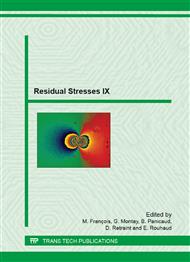[1]
U. Heckenberger, E. Hombergsmeier, V. Holzinger, W. von Bestenbostel, Advances in Laser Shock Peening theory and practice around the world: present solutions and future challenges, in G. Ivetic (Ed. ) Proceedings of the 2nd International Conference on Laser Peening, Emerald Group Publishing Ltd., Bradford, 2011, pp.22-33.
DOI: 10.1108/17579861111108581
Google Scholar
[2]
G. Ivetic, I. Meneghin, E. Troiani et al., Fatigue in laser shock peened open-hole thin aluminium specimens, Materials Science and Engineering A 534 (2012) 573-579.
DOI: 10.1016/j.msea.2011.12.010
Google Scholar
[3]
G. Ivetic, E. Troiani, I. Meneghin et al., Characterization of fatigue and crack propagation in laser shock peened open hole 7075-t73 aluminium specimens, in Proceedings of ICAF 2011 Symposium, Montreal, Canada, (2011).
DOI: 10.1007/978-94-007-1664-3_66
Google Scholar
[4]
C. Rubio-Gonzalez, J.L. Ocana, G. Gomez-Rosas, C. Molpeceres, M. Paredes, A. Banderas, J. Porro, M. Morales, Effect of Laser shock processing on fatigue crack growth and fracture toughness of 6061-T6 aluminium alloy, Material and Science Engineering A 386 (2004).
DOI: 10.1016/j.msea.2004.07.025
Google Scholar
[5]
S. Huang, J. Z Zhou, J. Sheng, K.Y. Luo, J. Z. Lu, Z. C. Xu, X. K. Meng, L. Dai, L. D. Zuo, H. Y. Ruan, H. S. Chen, Effects of Laser Peening with different coverage areas on fatigue crack growth properties of 6061-T6 aluminium alloy, International Journal of Fatigue 47 (2013).
DOI: 10.1016/j.ijfatigue.2012.09.010
Google Scholar
[6]
S. Huang, J. Z Zhou, J. Sheng, J. Z. Lu, G. F. Sun, X. K. Meng, L. D. Zuo, H. Y. Ruan, H. S. Chen, Effect of Laser Energy on fatigue crack growth properties of 6061-T6 aluminium alloy subjected to multiple laser peening, Engineering Fracture Mechanics 99 (2013).
DOI: 10.1016/j.engfracmech.2013.01.011
Google Scholar
[7]
D. Furfari, N. Ohrloff, E. Hombergsmeier, U. Heckenberger, V. Holzinger, Enhanced Fatigue and Damage Tolerance of Aircraft Components by Introduction of Residual Stresses – A Comparison of Different Processes, in A. Brot (Ed. ), Proceedings of ICAF 2013 Symposium, Jerusalem, Israel, (2013).
Google Scholar
[8]
P.C. Paris, H. Tada, G. Irwin, The Stress Analysis of Cracks Handbook, 3rd edition, p.127, ASME Press, New York, (2000).
Google Scholar
[9]
S. Taddia, E. Troiani, C. Crudo, Numerical Investigations on Laser Peening Process, in J.L. Ocana (Ed. ), Proceedings of the 4th international conference on laser shock peening and related phenomena, Madrid, Spain, (2013).
Google Scholar
[10]
E. Troiani, C. Crudo, G. Molinari, S. Taddia, Investigations on Laser Peening Capability by finite element simulations, in A. Brot (Ed. ), Proceedings of the ICAF 2013 Symposium, Jerusalem, Israel, (2013).
Google Scholar
[11]
G. Ivetic, I. Meneghin, E. Troiani, Numerical analysis of Laser Shock Peening as a process for generation of compressive residual stresses in open hole specimens, Materials Science Forum 681 (2011) 267-272.
DOI: 10.4028/www.scientific.net/msf.681.267
Google Scholar
[12]
H. Terada, Stress Intensity factor analysis and fatigue behaviour of a crack in the residual stress field of welding, Fatigue of aircraft structures 1 (2011) 5-15.
DOI: 10.2478/v10164-010-0032-8
Google Scholar
[13]
H. Tada, P.C. Paris, The stress intensity factor for a crack perpendicular to the welding bead, International Journal of Fracture 21 (1983) 279-284.
DOI: 10.1007/bf00942346
Google Scholar


